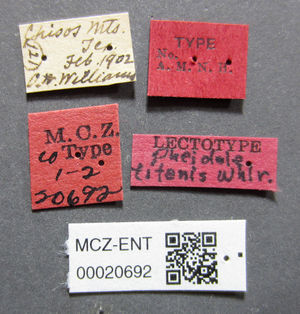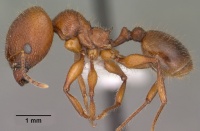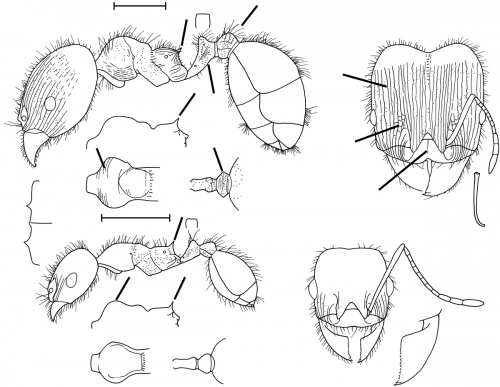Pheidole titanis
| Pheidole titanis | |
|---|---|

| |
| Scientific classification | |
| Kingdom: | Animalia |
| Phylum: | Arthropoda |
| Class: | Insecta |
| Order: | Hymenoptera |
| Family: | Formicidae |
| Subfamily: | Myrmicinae |
| Tribe: | Attini |
| Genus: | Pheidole |
| Species: | P. titanis |
| Binomial name | |
| Pheidole titanis Wheeler, W.M., 1903 | |
The species occurs in desert scrub and deciduous thorn forest, nesting under stones. As suggested by Creighton and Gregg (1955) and proved by Feener (1988), titanis is primarily a specialized predator on termites. In Jalisco, Feener found the species most often attacking foraging columns of Nasutitermes, only occasionally scavenging for dead arthropods of other kinds. Scouts recruit nestmates until a raiding force of 200–2000 majors and minors are assembled, encircling the termites, whereupon each ant tries to seize individual prey, then returns to the nest along the chemical recruitment trail. Feener has provided a detailed account of both the raiding behavior of titanis and their defensive maneuvers against enemies, especially parasitic phorid flies. (Wilson 2003)
Identification
As the name suggests, the majors of this species are very large, with the head length of the major exceeding 2 mm. The longitudinal rugae on the dorsum of the head extend onto the anterior portions of the posterior lateral lobes, the tops of the posterior lateral lobes of the major are shiny. The pronotum of the major has several transverse striae. (Mackay and Mackay 2002)
Also see the description in the nomenclature section.
Keys including this Species
Distribution
Western Texas, southern Arizona and Jalisco, Mexico. (Wilson 2003)
Latitudinal Distribution Pattern
Latitudinal Range: 34.156971° to 19.46°.
| North Temperate |
North Subtropical |
Tropical | South Subtropical |
South Temperate |
- Source: AntMaps
Distribution based on Regional Taxon Lists
Nearctic Region: United States (type locality).
Neotropical Region: Mexico.
Distribution based on AntMaps
Distribution based on AntWeb specimens
Check data from AntWeb
Countries Occupied
| Number of countries occupied by this species based on AntWiki Regional Taxon Lists. In general, fewer countries occupied indicates a narrower range, while more countries indicates a more widespread species. |

|
Estimated Abundance
| Relative abundance based on number of AntMaps records per species (this species within the purple bar). Fewer records (to the left) indicates a less abundant/encountered species while more records (to the right) indicates more abundant/encountered species. |

|
Biology
In his original description of Pheidole titanis Wheeler observed that it prefers to nest under large boulders or where the soil is full of good-sized stones. It also seems to prefer nest sites near streams in canyons. The nest is usually placed near the top of the bank ten feet or more above the stream bottom. In the three nests which were excavated there was no evidence that the insects had been collecting seeds. But there is ample evidence that titanis eats termites. The colony taken at Sweetwater did so avidly; indeed, they would snatch their victims from between the tips of the tweezers by which the termites were presented to them. The colony taken in Brown Canyon was discovered when a column of majors and minors, most of them with termites in their jaws, was returning to the nest. (Creighton and Gregg 1955)
Association with Other Organisms
 Explore: Show all Associate data or Search these data. See also a list of all data tables or learn how data is managed.
Explore: Show all Associate data or Search these data. See also a list of all data tables or learn how data is managed.
- This species is a host for the chalcid wasp Notaspidium sp. (a parasite) (Universal Chalcidoidea Database) (associate).
- This species is a host for the phorid fly Apocephalus sp. (a parasitoid) (Quevillon, 2018) (encounter mode primary; direct transmission; transmission outside nest).
Castes
Worker
Minor
Images from AntWeb
   
| |
| Worker. Specimen code casent0104450. Photographer Jen Fogarty, uploaded by California Academy of Sciences. | Owned by CAS, San Francisco, CA, USA. |
Major
   
| |
| . | Owned by Museum of Comparative Zoology. |
Nomenclature
The following information is derived from Barry Bolton's Online Catalogue of the Ants of the World.
- titanis. Pheidole titanis Wheeler, W.M. 1903b: 95, fig. 3 (s.w.) U.S.A. See also: Wilson, 2003: 602.
Unless otherwise noted the text for the remainder of this section is reported from the publication that includes the original description.
Description
From Wilson (2003): DIAGNOSIS A large member of the pilifera group further characterized by the following traits.
Major: rugoreticular patch just mesad of each frontal carina and posterior to the antennal fossa; the rest of the dorsal surface of the head except for the occiput, central piece of the clypeus, and frontal triangle longitudinally carinulate; median carina present on the clypeus; carinulae cover anterior third and sides of the pronotal dorsum, part of the propodeal dorsum, sides of the petiole, and dorsum of the postpetiolar node; postpetiolar node from above diamond-shaped.
Minor: head subrectangular in full-face view; humerus lobose in dorsal-oblique view; postpetiole bell-shaped from above.
MEASUREMENTS (mm) Lectotype major: HW 1.94, HL 2.02, SL 0.98, EL 0.30, PW 1.10. Paralectotype minor: HW 0.92, HL 0.94, SL 0.86, EL 0.24, PW 0.60.
COLOR Major and minor: concolorous light reddish brown.
Figure. Upper: lectotype, major. Lower: paralectotype, minor. Scale bars = 1 mm.
Worker
Major Length 7.25-8 mm.
Head proportionally small, hardly larger than the gaster, a little longer than broad, excluding the mandibles, subcordate, somewhat broader behind than in front, with prominent rounded posterior corners; posterior border deeply excised in the middle. A deep groove extends from this excision to the frontal area. Mandibles robust, convex, with flattened, edentulous, and nearly straight blades which terminate in two prominent apical teeth. Clypeus short, its anterior border deeply excised in the middle, feebly and sinuately concave on either side; median surface rather flat and depressed. Frontal area triangular, as long as wide. Frontal carinae long, diverging, continued backward nearly to the middle of the head. Antennae very small, scape distinctly flattened but hardly incrassated, reaching only to a little beyond the posterior orbit; funiculus slender, its joints all decidedly longer than broad, club very short and indistinctly marked off from the remainder of the funiculus. Eyes moderate, round, at about one third the distance from the anterior to the posterior border of the head. Thorax robust; pronotal angles obtusely rounded; mesoepinotal constriction rather deep; epinotal declivity concave; spines robust, pointed, longer than broad at the base and farther apart than long; slightly curved downwards at their tips. Petiole pedunculate, seen from above constricted near the middle; in profile the dorsal surface is concave in front, convex on the anterior surface of the node, posterior declivity straight and abrupt; upper margin of node distinctly concave in the middle when seen from behind. Postpetiole transversely elliptical from above, nearly twice as broad as long and fully twice as broad as the petiole, with distinct but not very prominent lateral angles near the middle; in profile the dorsal surface is very convex, the ventral surface much more flattened. Gaster elongate elliptical, rather large. Legs long, femora conspicuously incrassated in the middle, the tibiae towards their distal ends.
Mandibles smooth and shining, with a few scattered piligerous punctures and some pronounced striae on the outer basal margin. Clypeus shining in the middle, more opaque at the sides which are coarsely longitudinally rugose. There is a prominent median ruga. Frontal area shining, with a median carinula. Head subopaque covered with rather coarse, parallel, longitudinal rugae over the anterior three quarters, posterior fourth smooth and shining, with a few scattered and shallow foveolae. Spaces between the rugae fined with minor reticulations which extend back somewhat beyond the ends of the main rugae on to the smooth occipital .surface. Thorax subopaque, pro- and mesonotum more shining, pronotum and sides of mesonotum with several sharp transverse rugae. Mesopleurae and whole epinotum coarsely punctate rugulose. Petiole and postpetiole opaque, punctate rugulose throughout. Gaster hardly shining, as its surface is finely reticulate and irregularly and rather densely punctate; only the basal portions of the segments where they are overlapped by preceding segments when the gaster is not distended, are smooth and shining. Antennae and legs smooth and shining, scape, tibiae, and femora with scattered piligerous punctures.
Whole insect covered with rather long, coarse, yellow hairs, which are erect or suberect on the body, antennal scape, and legs, but shorter and less conspicuous on the funiculus and tarsi.
Rich ferruginous red, thorax and petiole somewhat darker, edges of mandibular blades. anterior border of clypeus, epinotal spines and gaster black, the posterior edges of the gastric segments yellowish, the basal half of the first gastric segment sometimes ferruginous.
Minor Length 4-4.5 mm.
Head, excluding the mandibles. as broad as long; posterior angles rounded. Mandibles with two prominent apical teeth and the remainder of their blades finely crenulate. Clypeus short, its anterior border straight, faintly and sinuately excised in the middle, posterior median surface strongly convex. Frontal area triangular, rather indistinct. Antennae slender. scape slightly thickened distally. extending beyond the posterior corner of the head to a distance about one third of its length; funiculus with all its joints distinctly longer than broad, joints 2-7 subequal, fully twice as long as broad; club appearing 4-jointed as the 8th joint forms a transition between the basal and terminal joints. Thorax much like that of the soldier. but with less robust and narrower prothorax; epinotal spines more slender, straight and pointed. Petiole slender, more than twice as long as broad, node rounded, hardly transverse. Postpetiole as long as broad, campanulate, nearly twice as broad as the petiole. Gaster and legs of the usual shape.
Smooth and shining; mandibles, head, and gaster with sparse piligerous punctures; head in front of eyes longitudinally rugose as is also the region between and next to the frontal carinae. Mesopleurae, epinotum, ventral and lateral surfaces of the petiole and postpetiole subopaque, reticulate punctate.
Pilosity similar to that of the soldier but less abundant.
Black or very dark reddish brown. Mandibles, anterior portion of head, pro- and mesopleurae reddish yellow. Antennae and legs reddish yellow, scape and femora darker.
Type Material
Chisos Mts., Brewster Co., southwestern Texas. Described from numerous specimens taken in the Paisano Pass, Brewster County, by myself, and in the Chisos Mts. by Judge O. W. Williams. The single nest found in the Paisano Pass was between huge immovable boulders embedded in the soil, so that I could secure only the workers, but Judge Williams obtained great numbers both of the soldiers and workers from a large nest under a stone near the foot of the Chisos.
Etymology
Gr titanus, or a mythical race of giants. (Wilson 2003)
References
- Wilson, E. O. 2003. Pheidole in the New World: A dominant, hyperdiverse ant genus. Harvard University Press, Cambridge, MA. (page 602, fig. major, minor described)
- Creighton, W. S. and R. E. Gregg. 1955. New and little-known species of Pheidole (Hymenoptera: Formicidae) from the southwestern United States and northern Mexico. Univ. Colo. Stud. Ser. Biol. 3: 1–46.
- Feener, D. H., Jr. 1988. Effects of parasites on foraging and defense behavior of a termitophagous ant, Pheidole titanis Wheeler. Behav. Ecol. Sociobiol. 22: 421–427.
- Mackay, W. P. and E. Mackay. 2002. The ants of New Mexico (Hymenoptera: Formicidae). Edwin Mellen Press, Lewiston, NY.
- Vázquez-Franco, C.M., Morrone, J.J. 2022. The genus Pheidole (Hymenoptera: Formicidae: Myrmicinae) in Puebla, Mexico. Revista Mexicana de Biodiversidad 93: e933820 (doi:10.22201/ib.20078706e.2022.93.3820).
- Wheeler, W. M. 1903c. A decad of Texan Formicidae. Psyche (Camb.) 10: 93-111 (page 95, fig. 3 soldier, worker described)
References based on Global Ant Biodiversity Informatics
- Cover S. P., and R. A. Johnson. 20011. Checklist of Arizona Ants. Downloaded on January 7th at http://www.asu.edu/clas/sirgtools/AZants-2011%20updatev2.pdf
- Dattilo W. et al. 2019. MEXICO ANTS: incidence and abundance along the Nearctic-Neotropical interface. Ecology https://doi.org/10.1002/ecy.2944
- Gregg R. E. 1959. Key to the species of Pheidole (Hymenoptera: Formicidae) in the United States. Journal of the New York Entomological Society 66: 7-48.
- Johnson R. Personnal Database. Accessed on February 5th 2014 at http://www.asu.edu/clas/sirgtools/resources.htm
- MacGown J. A., T. L. Schiefer, and M. G. Branstetter. 2015. First record of the genus Leptanilloides (Hymenoptera: Formicidae: Dorylinae) from the United States. Zootaxa 4006 (2): 392–400.
- Moody J. V., and O. F. Francke. 1982. The Ants (Hymenoptera, Formicidae) of Western Texas Part 1: Subfamily Myrmicinae. Graduate Studies Texas Tech University 27: 80 pp.
- O'Keefe S. T., J. L. Cook, T. Dudek, D. F. Wunneburger, M. D. Guzman, R. N. Coulson, and S. B. Vinson. 2000. The Distribution of Texas Ants. The Southwestern Entomologist 22: 1-92.
- Van Pelt, A. 1983. Ants of the Chisos Mountains, Texas (Hymenoptera: Formicidae) . Southwestern Naturalist 28:137-142.
- Vásquez-Bolaños M. 2011. Lista de especies de hormigas (Hymenoptera: Formicidae) para México. Dugesiana 18: 95-133
- Wheeler W. M. 1903. A decad of Texan Formicidae. Psyche (Cambridge). 10: 93-111.
- Wheeler, G.C. and J. Wheeler. 1985. A checklist of Texas ants. Prairie Naturalist 17:49-64.
- Wilson, E.O. 2003. Pheidole in the New World: A Dominant, Hyperdiverse Genus. Harvard University Press



